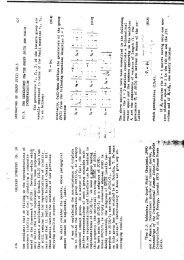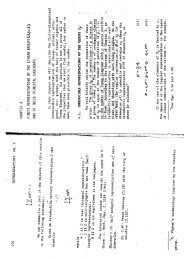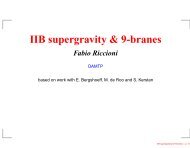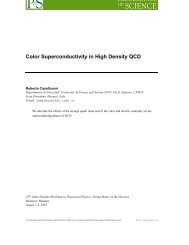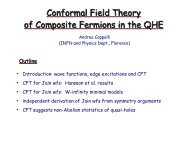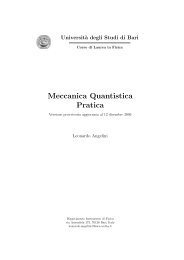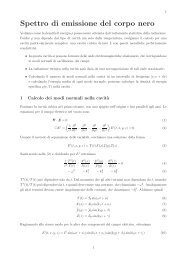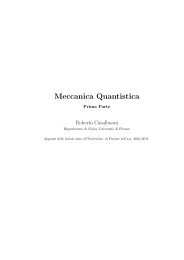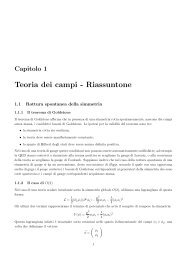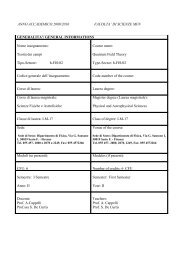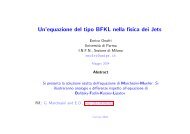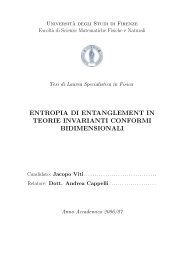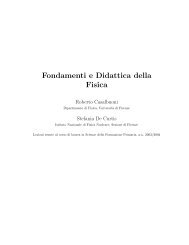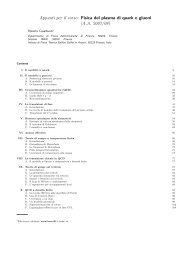arXiv:hep-ph/9804260 v2 16 Jun 1998 - Florence Theory Group
arXiv:hep-ph/9804260 v2 16 Jun 1998 - Florence Theory Group
arXiv:hep-ph/9804260 v2 16 Jun 1998 - Florence Theory Group
You also want an ePaper? Increase the reach of your titles
YUMPU automatically turns print PDFs into web optimized ePapers that Google loves.
aryon properties [17] it seems somewhat unmotivated. A more natural model choice<br />
would rather employ vector meson [18] or chiral quark [20] models. The reason being that<br />
these mesonic degrees of freedom need to be included in order to obtain non–vanishing<br />
neutron–proton mass differences as well as a finite axial singlet current matrix element<br />
of the nucleon [21]. In these models meson fields, which vanish classically, are induced by<br />
the collective rotation A(t) in eq (2.8). As it is yet unknown how to treat the breathing<br />
mode in the presence of these induced fields the model may be considered as an effective<br />
parameterization of massive meson fields. A particular difficulty with these induced<br />
fields is that the corresponding stationary conditions must separately be solved for every<br />
value of the scaling coordinate x in order to maintain the correct normalization of the<br />
Noether currents. In vector meson models this problem occurs already on the classical<br />
level for the time component of the ω field because its stationary condition actually<br />
is a constraint which guarantees the positivity of the classical energy functional. The<br />
incorporation of the breathing coordinate in an SU(2) vector meson model was attempted<br />
in ref [19], however, the above mentioned subtleties were ignored. In non–topological<br />
chiral quark soliton models their non–confining character may cause additional problems<br />
when treating the breathing mode dynamically because a transition to the trivial meson<br />
configuration may occur [15].<br />
To be specific we will follow the treatment of ref [17] where the soliton model not<br />
only contains the pseudoscalar mesons φ a but also an effective scalar meson field H =<br />
〈H〉exp(4σ) which is introduced to mock up the QCD anomaly [22] for the dilatation<br />
current<br />
−∂µD µ = H + <br />
i<br />
mi ¯ ΨiΨi where H = − β(g)<br />
g Ga µν Gaµν . (2.1)<br />
The vacuum expectation value 〈H〉 ∼ (0.30 − 0.35GeV) 4 can be extracted from sum<br />
rule estimates for the gluon condensate [23]. Eventually the fluctuating field σ may be<br />
identified as a scalar glueball. The effective mesonic action reads<br />
<br />
Γ =<br />
d 4 x (L0 + LSB) + ΓWZ . (2.2)<br />
The flavor symmetric part involves both the chiral field 1 U = exp(iλ a φ a /fa) as well as<br />
the scalar gluonic fluctuation σ<br />
L0 = − f2 π<br />
4 e2σ tr(αµα µ ) + 1<br />
32e<br />
+ 1<br />
2 Γ2 0 e2σ ∂µσ∂ µ σ + e 4σ<br />
<br />
2tr [αµ, αν] 2<br />
<br />
1<br />
4 [〈H〉 − 6 (2δ′ + δ ′′ <br />
)] − σ〈H〉<br />
1 Here the normalization coefficients fa refer to the pseudoscalar decay constants.<br />
4<br />
(2.3)



